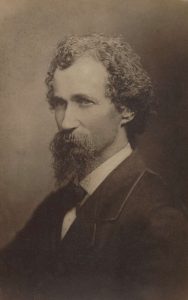
(Click here for a list of his works.)
Kendall was born in Ulladulla, New South Wales, on 18 April 1839 (along with a twin brother, Basil). His parents were Basil Kendall (senior) and Melinda Kendall (née McNally). Although he was baptised as Thomas Henry Kendall, he was later to call himself Henry Clarence Kendall, possibly taking his new name from the Clarence River (NSW), which he lived near as a youngster.[2]
When he became an adult, he worked on a whaling ship, then became a clerk in a solicitor’s office, and afterwards got a job as a clerk in the public service in New South Wales.[3] In March 1868 the 28-year-old Kendall married 18-year-old Charlotte Rutter. Due to some financial problems, brought about by his siblings, he resigned his job with the public service, and moved to Melbourne. He submitted his poetry to various publications; however, he had trouble surviving on the proceeds of his works, despite the highly favourable reviews given to them.
His first book of poetry was published in 1862, Poems and Songs. In 1869, his second collection of poetry was published, Leaves from Australian Forests; but, like his first book, it was not a financial success.
With his descent into poverty, he turned to drink, and his health deteriorated. He moved back to Sydney, but his problems continued. In 1870 he was charged with forging a cheque, but found not guilty on account of insanity. Still without decent financial means, Kendall became a derelict, and in 1873 he spent several months in the Gladesville Hospital for the Insane, although his stay was more likely connected with a dependence upon alcohol rather than clinical insanity.
After his stint in hospital, he was taken care of for a long time by some friends, the Fagan family in West Gosford, and, when recovered, worked in their timber business.[4]
In 1880 Kendall produced his third collection of poetry, Songs from the Mountains; this book, at least, made a profit, albeit only a small one.[5]
In April 1881 Henry Parkes (the Premier of New South Wales, a fellow poet, and one of Kendall’s admirers) gave him a job as a forest inspector; however, Kendall’s physical constitution was not up to the task. He collapsed in June of the following year, and died of phthisis in Surry Hills, New South Wales, on 1 August 1882.
Kendall was noteworthy for including Australia’s fauna, flora, and lifestyle in his poetry, in a positive manner — not disparaging the Australian bush, as various authors had done before him, and also breaking away from the previously often-used European-styled literature. Bertram Stevens noted that several approving reviews of Kendall’s poetry were published in the influential Athenaeum literary magazine (published in London) between 1862 to 1866. Such noteworthy acclaim would have boosted his reputation and given him added influence in Australian society. Stevens said of Kendall that “He lived at a time when Australians had not learned to think it possible that any good thing in art could come out of Australia”; the poet helped to change that perception with his verses of Australian settings and subjects.[6]
The Sydney Morning Herald, in its obituary for Kendall, published the day after his death, said “With the exception, perhaps, of Adam Lindsay Gordon, there is no poetic writer whose works breathe a purer Australian spirit, or are more deeply marked with the influence of the life and scenes of these lands.”[7]
The Rev. Alfred Gifford once stated that “Henry Kendall marked the beginning of Australian poetry”[8]. High praise indeed for a young lad hailing from an isolated town on the southern coast of New South Wales.
Books and other works by Henry Kendall:
Works by Henry Kendall
Articles about Henry Kendall:
(Arranged in date order.)
Henry Kendall, the N.S.W. poet [21 August 1886]
An article about a planned monument for the grave of Henry Kendall.
Unveiling of the monument to Henry Kendall [27 November 1886]
An article about the unveiling of a monument on the grave of Henry Kendall.
Poetry in Australia [20 November 1894]
This article is critical of Adam Lindsay Gordon and Henry Clarence Kendall, but praises the work of Henry Lawson.
Henry Kendall: Gosford associations: The Poet’s Rock [27 March 1934]
An article about Henry Kendall’s connection to the Godford area, and his writings about Daniel Deniehy and Charles Harpur.
Poetry about Henry Kendall:
Kendall [poem by Kenneth Mackay, 1887]
References:
[General reference] T. T. Reed, “Kendall, Thomas Henry (1839–1882)”, Australian Dictionary of Biography, National Centre of Biography, Australian National University
[1] “Henry Kendall: Gosford Associations: The Poet’s Rock”, The Wingham Chronicle and Manning River Observer (Wingham, NSW), 27 March 1934, p. 1
[2] Henry Kendall in Illawarra, Research Online, University of Wollongong [Illawarra Historical Society Bulletin, 1 April 1984, pp.15-16, 1 May 1984, pp. 19-20]
Henry Kendall, Monument Australia
[3] A.T.C., “Henry Kendall’s poems”, The South Australian Advertiser (Adelaide, SA), 9 April 1887, p. 5
[4] “Our history”, Henry Kendall Cottage and Historical Museum
[5] “Henry Kendall”, Windsor and Richmond Gazette (Windsor, NSW), 17 August 1928, p. 1
[6] Bertram Stevens, “Introduction”, in: Bertram Stevens (ed.), The Golden Treasury of Australian Verse, London: Macmillan and Co., 1909, pp. xvii-xxviii (see pp. xxiii, xxvi)
[7] “The late Mr. Henry Kendall”, The Sydney Morning Herald (Sydney, NSW), 2 August 1882, p. 3
[8] “Australian poetry”, The Advertiser (Adelaide, SA), 7 August 1917, p. 7
Further reading:
“Henry Kendall (poet)”, Wikipedia
Last updated: 19 February 2023
Leave a Reply